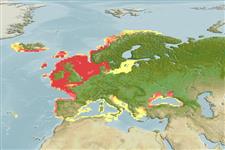Environment: milieu / climate zone / depth range / distribution range
Ecologia
marino; salmastro benthopelagico; oceanodromo (Ref. 51243); distribuzione batimetrica 10 - 200 m (Ref. 1371), usually 30 - 100 m (Ref. 1371). Temperate; 72°N - 35°N, 27°W - 42°E
Northeast Atlantic: southeastern Barents Sea and Iceland to Portugal, also in the Black Sea, Aegean Sea, Adriatic Sea and adjacent areas. Rare in the northwestern Mediterranean.
Length at first maturity / Size / Peso / Age
Maturity: Lm 28.2, range 28 - 30 cm
Max length : 91.5 cm TL maschio/sesso non determinato; (Ref. 106276); common length : 23.5 cm TL maschio/sesso non determinato; (Ref. 1371); peso massimo pubblicato: 3.1 kg (Ref. 40637); Età massima riportata: 20 anni (Ref. 35388)
Spine dorsali (totale): 0; Raggi dorsali molli (totale): 30-40; Raggi anali molli: 30 - 35. Body elongate; head small. Chin barbel small or absent. Lateral-line canals on head with pores. Color is variable; yellowish-brown, dark blue or green, sides yellowish grey, white and silvery on belly; often with a small dark blotch at the upper base of the pectoral fin.
More commonly found from 30 to 100 m, mainly on mud and gravel bottoms, but also on sand and rock. Feed on shrimps, crabs, mollusks, small fish, polychaetes and cephalopods. Migrate to the open sea only after the first year of life. Eggs are pelagic. Larvae and juveniles are associated with jellyfish. Upon maturity, small chin barbel characteristic of juveniles disappear (Ref. 53061). Spawn in batches (Ref. 51846). Utilized fresh, dried or salted, smoked and frozen; eaten steamed, broiled and baked (Ref. 9988).
Oviparous, sexes are separate (Ref. 205).
Cohen, D.M., T. Inada, T. Iwamoto and N. Scialabba, 1990. FAO species catalogue. Vol. 10. Gadiform fishes of the world (Order Gadiformes). An annotated and illustrated catalogue of cods, hakes, grenadiers and other gadiform fishes known to date. FAO Fish. Synop. 125(10). Rome: FAO. 442 p. (Ref. 1371)
IUCN Red List Status (Ref. 130435)
Threat to humans
Harmless
Human uses
Warning: mysqli::__construct(): (HY000/1040): Too many connections in /var/www/html/includes/func_getlabel.php on line 46
Can't connect to MySQL database (fbapp). Errorcode: Too many connections
